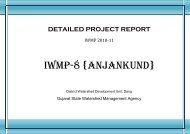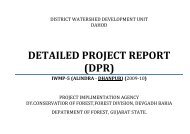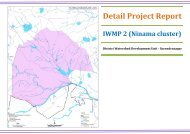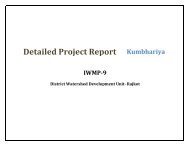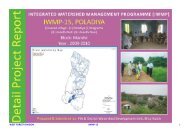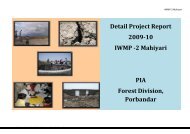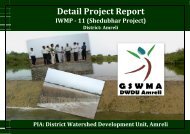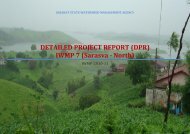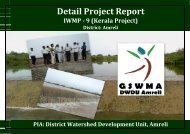Detailed Project Report - Commissionerate of Rural Development ...
Detailed Project Report - Commissionerate of Rural Development ...
Detailed Project Report - Commissionerate of Rural Development ...
Create successful ePaper yourself
Turn your PDF publications into a flip-book with our unique Google optimized e-Paper software.
District Watershed <strong>Development</strong> Unit - Jamnagar<br />
Watershed Activities<br />
Watershed management as a strategy has been adapted by Government <strong>of</strong> India especially in the rainfed regions <strong>of</strong> semi-arid tropics. These<br />
regions are characterized by low and undependable rain, low soil fertility, poor infrastructure development, low literacy and high incidence <strong>of</strong><br />
migration. The inheriting low fertility <strong>of</strong> crops results in high productivity <strong>of</strong> crops which have a very low biological efficiency.<br />
Several studies have identified that there is a dire need <strong>of</strong> a systematic and scientific approach to deal with watershed development. The common<br />
guidelines generate a fresh and flexible framework for the next generation watershed development.<br />
4.1 Scientific Planning:<br />
1. Cluster Approach<br />
This envisages a broader vision <strong>of</strong> Geo-hydrological unit which involves treating a cluster <strong>of</strong> micro-watershed. The Patan <strong>Project</strong> consists <strong>of</strong> three<br />
micro- watersheds namely 5G1A8b2h, 5G1A8b2i, 5G1A8b2g, 5G1A8b2j, 5G1A8b2k, 5G1A8b2f, 5G1A5a2e 5G1A5c2j 5G1A5a2f as their<br />
respective codes. Further Patan watershed project is in continuation with other watershed project namely Vansjaliya <strong>Project</strong> this gives an element<br />
<strong>of</strong> continuation <strong>of</strong> the programme.<br />
2. Base line Survey<br />
To access the impact <strong>of</strong> any watershed development programme a detailed baseline survey has to be conducted. This acts a benchmark for any<br />
intervention during and post implementation <strong>of</strong> any development programme. A detailed baseline survey has been undertaken which involved<br />
household census survey, Bio-physical survey and Village level data collection from Talati -cum mantri. Household census survey includes a<br />
detailed questionnaire which has been filled by visiting each and every house-hold in the village. This provide the details <strong>of</strong> the demographic<br />
pr<strong>of</strong>ile <strong>of</strong> the village, the literacy percentage, SC/ST population, number <strong>of</strong> BPL household, cattle population, net consumption rate in the village,<br />
average milk production <strong>of</strong> the cattle, social and economic condition <strong>of</strong> villagers and various schemes running and their benefits.<br />
Bio-physical survey has been undertaken to identify various natural resources available in the village. It included the soil typology, well in the area,<br />
crop taken in the field, Cropping pattern, fertilizer used and various sources <strong>of</strong> irrigation in the field.<br />
3. Participatory <strong>Rural</strong> Appraisal (PRA)<br />
<strong>Detailed</strong> <strong>Project</strong> <strong>Report</strong> – IWMP-1 (Patan )



